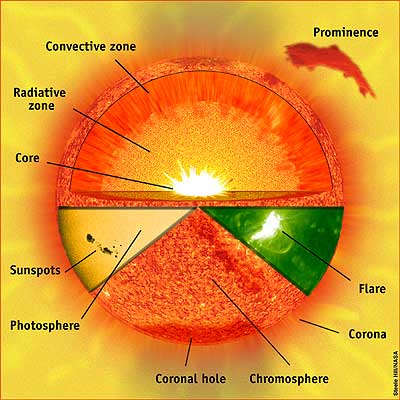
We now look to the very center of our solar system, which is the "star" of the show - our sun (sorry about the pun). This magnificent ball of hydrogen has been illuminating our solar system for about 5 billion years and provides us with the light and heat we need to live and survive. At first glance (don't glance at the sun), the sun may seem to be unchanging and perpetual. Not so. The sun, like all things in this universe, has a beginning and an end. During its life, it undergoes changes, both gradual and short term. Astronomers are aware of many violent events that occur on the sun and that these events can have a direct effect on Earth. We are literally at the mercy of this closest star.
Sun facts:

Courtesy of SOHO
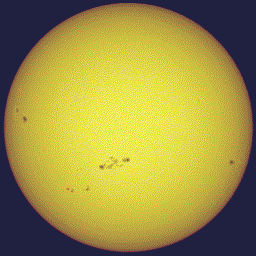
Credit NASA
The sun rotates, ... taking about a month to complete one spin (animation)
The image above shows sunspots in the photosphere. The name comes from the Greek words photos (light) and sphere (ball) ... "ball of light". There are layers of gas below and above the photosphere. The reason this layer stands out is because it represents the last opaque layer in the solar atmosphere. Layers of gas above the photosphere are transparent. That is, visible photons are not affected by the gases they move through, and travel unhindered through space. Photons in the opaque photosphere are constantly being absorbed and re-emitted in random directions. The animation below attempts to illustrate this difference.
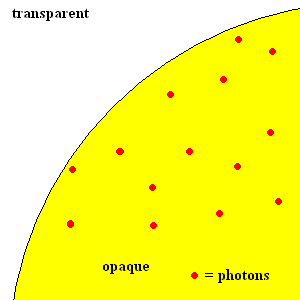
Why the sun appears to have an edge (animation)
Directly above the photosphere is a thin layer known as the chromosphere. If you look closely at the image (which I took during a total solar eclipse), you will see small patches of red which represents activity in the chromosphere. However, you can easily see the corona, ... an irregular, fuzzy haze which can extend to several solar radii. The corona gives off about the same amount of light as the full moon, but is normally washed out by the glare of the photosphere.
|
Taken 8/11/1999 |
Solar Corona: Credit NASA |
Credit NASA Coronal Hole |
One of the big mysteries concerning the corona is its temperature. It reaches millions of degrees, but no one knows why. It certainly has something to do with the way the magnetic field behaves in this region of the sun, but the details have eluded us. Another event that occurs in this region are "coronal holes" (see image above taken in X-rays). These holes act like windows, allowing high speed plasma to escape the sun in highly energetic events known as coronal mass ejections (CME's).
Seen close up, the photosphere is an extremely violent conflict between hotter and cooler gases. What you are seeing is hot material rising from below (making the light patches) and cooler material sinking downward (dark areas). Click on this link which shows this in action, known as solar granulation. These features change in the order of minutes.

Solar granules Credit NASA
Sunspots -
Ever since Galileo observed the sun, astronomers have been studying sunspots. Spots appear in small groups and represent "magnetic storms" in the photosphere. The individual spots appear dark (in contrast) because they are a few thousand degrees cooler than the surrounding photosphere. Most spot groups lasts only a few weeks and large spots may last a month. After studying the sun over hundreds of years, a pattern of sunspot activity revealed itself - the sunspot cycle. Approximately every 11.1 (on average) years, the sun breaks out in a rash (see chart below). Click here to see where we are now in the sunspot cycle. The last peak was around 2014. We are currently in Solar Cycle 25 and the peak is expected to occur around 2025 but the peak may be coming sooner than predicted (remember, 11 years is only an average).
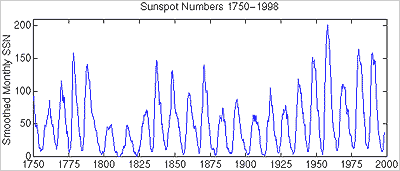
Credit NASA
Oddly enough, the sun goes through a magnetic flip-flop at the end of each cycle (magnetic north and south switch around), so you might argue that the sun really has a 22 year cycle.
The active sun
When the sun is "active", ... that is, it is near the peak of sunspot activity, other solar events also occur frequently. These events include flares, prominences (video), and coronal mass ejections or CME's. Basically these all involve high speed plasma (charged particles) blasting off the sun. The sun always emits a gentle flow of plasma (solar wind), but these events are orders of magnitude above this normal level of activity. Click here to see what is happening on the sun now.
Solar FlareCredit: Holloman AFB/NOAA
Solar ProminenceCredit: Skylab/NASA
Material ejected by the sun during an active period can occasionally interact with Earth. Fortunately, the earth's magnetic field shields us from this deadly particle radiation as it gets deflected along the magnetic field towards the earth's poles. This can produce aurora (northern lights) and disrupt sensitive electronics.
|
from sun |
Image of an aurora |
This is a great question to which no one has a perfect answer. Astronomers are quite sure that the sun (like Earth) has different layers which we can not see.
The interior of the sun
In the center is the core (depicted in red). This is the source of all the energy we see at the photosphere. The layer just outside the core is the radiative zone. Energy (in the form of photons) slowly works through this zone as photons randomly interact with the hydrogen gas and zigzag in different directions. In time, they eventually move away from the core and closer to the surface The next layer is the convective zone. This layer is slowly churning over, delivering heat from the interior up toward the photosphere. Photons are still randomly moving around in this layer, however. Astronomers believe that the magnetic field of the sun originates in the thin layer between the radiative zone and the convection zone where plasma produces a dynamo effect. Any magnetic field produced by the sun has to obey the known laws of physics, ... and one of those laws says that magnetic field lines must always form a closed loop. We know that the magnetic lines extend out of the poles of the sun but how do they behave in the interior? One model suggests that the whole problem originated because the sun is a gas and that it rotates at different speeds at different latitudes. Any magnetic field lines in the sun's interior would, therefore, get slowly stretched like a rubber band as a result. In time, the magnetic stress would be so great that the lines literally pop through the photosphere, and we see sunspots as a result. See the animation below.
Do stressed magnetic field lines result in sunspots? (animation)
All the light and heat we get from the sun originated in its core. Before physics understood the nature of the atom, the question of what powered the sun was a total mystery. However, with the advent of nuclear energy, it became clear that the sun derives its energy from the process of nuclear fusion. If you want to make a hydrogen bomb, all you need to do is get hydrogen very hot and under a lot of pressure, ... and that is exactly the conditions you find in the core of the sun. In this process, 4 hydrogen atoms are fused to make 1 helium atom (plus the release of energy in the form of gamma rays ... and some other subatomic particles). The exact process is quite a bit more complicated than this, taking several individual steps, but we can leave out these details. The energy comes from Einstein's famous equation:
E = Mc2
Where E = energy, M = mass, and c is the speed of light
This equation is just a conversion factor behind an insightful idea that energy and matter are interchangeable. As hydrogen is being fused into helium in the core of the sun, a small amount of mass disappears, and energy takes its place. Every second, 600 million tons of hydrogen are turned into helium and in the process, the sun is losing about 4 million tons of mass each second. Before you think the sun is going to shrivel away, just remember that this process has been going on in the core of the sun for 5 billion years, and its mass has dipped less than 1%.
The gamma ray photons that are produced in the core of the sun today will not show themselves to us for a very long time. As they randomly move through the radiative zone and then the convective zones, they are undergoing many changes in the process. If you recall from an earlier discussion, the energy a photon contains is different for each color of light. Photons of red light have less energy than photons of violet light. Gamma ray photons have the highest energy of them all. As a photon tunnels out of the core of the sun, it is constantly interacting with the matter in each layer, being absorbed and eventually re-emitted by atoms. However, the re-emitted photons do not necessarily have to be identical to the photons first absorbed (although the energy must still balance). To help illustrate the point, think of money as if it were energy. Say a photon of gamma rays is like a hundred dollar bill, and represents a huge amount of energy. You can go to the bank and exchange the hundred dollar bill for 2 fifty dollar bills. Later you can exchange these bills for a handful of twenties and tens. In time, you can end up with pockets of dollar bills and fives. Eventually you have a wheelbarrow filled with pennies, nickels and dimes. This is exactly what happens to the photons that are created in the core of the sun. By the time they reach the top of the photosphere, they have spent a few hundred thousand years (perhaps millions of years) interacting with the gases, and produced an assortment of lower energy photons in the UV, visible, and infrared portions of the spectrum. The light we see today was actually created long ago in the core of the sun in the form of deadly gamma rays.
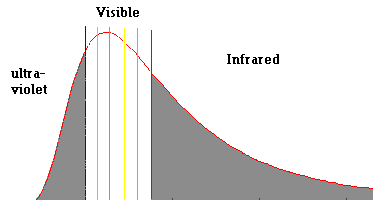
Spread of energy leaving the photosphere of the sun
Since the sun started fusion in its core (about 5 billion years ago), it has undergone slight, long-term changes. Our younger sun put out about 30% less radiation than it does now. The stability of the sun is achieved because gravity pulling inward is matched by radiation pressure pushing outward. As the core converts hydrogen into helium, it is slowly changing its composition and therefore its density. In time, this makes it slightly more efficient as a "fusion machine", ... meaning there is a slightly higher flux of radiation leaving the core than there was in the distant past. The end result is a sun which is putting out more radiation now than it did when it was young. This is interesting because records of the earth's past climate show that we were (on average) much warmer than we are today. This led to a problem known as the faint young sun paradox. Climatologists believe that a very active carbon cycle was at work on Earth (and still is). With much more CO2 (and more other greenhouse gasses like methane) in the air, the atmospheric heating by the greenhouse effect more than made up for a young dim sun.
The sun will continue to slowly get brighter. What does this mean for our future? Some predictions are not promising. One computer model predicts that the slow warming of the sun will overwhelm our planet in a mere 1.5 billion years, ... turning us into another Venus. We will discuss the eventual fate of our sun in the next unit.
ŠJim Mihal 2004, 2014, 2020, 2023 - all rights reserved